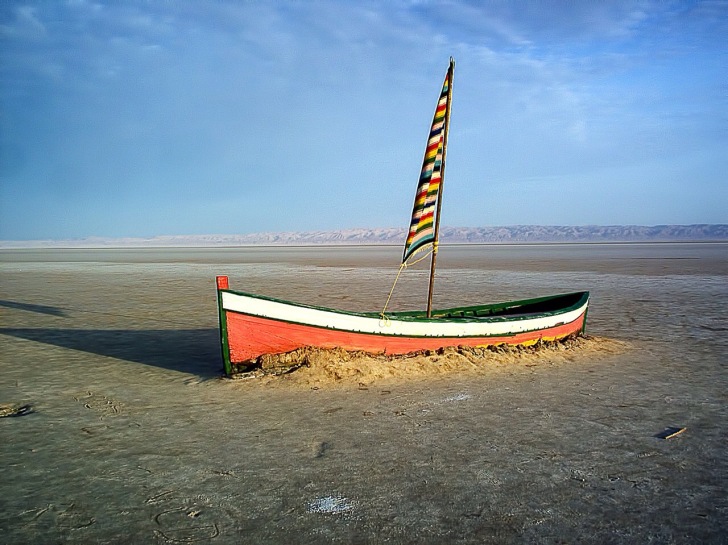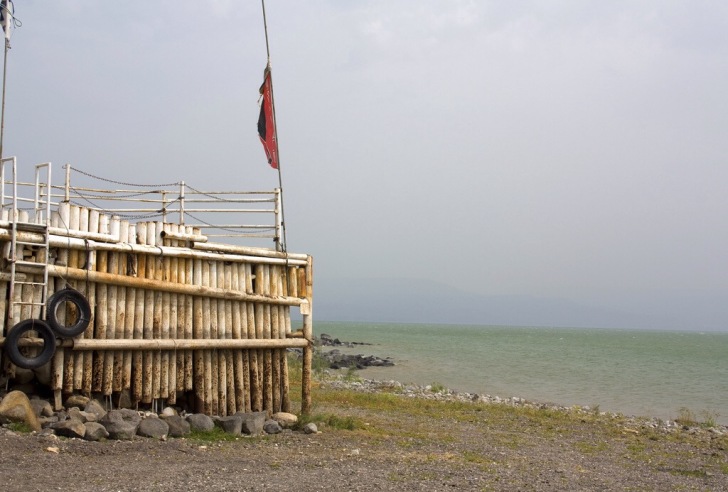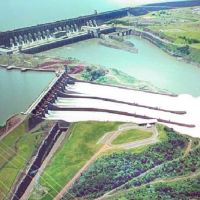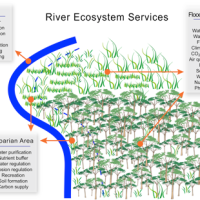Low water and high salinity: the effects of climate change and water abstraction on lake ecosystems

Boat on a dry Tunisian lake. Image: Pixaweb | Creative Commons
The fifth IPCC report, published in 2014, states that climate-related risks to freshwater ecosystems will increase in the future if greenhouse gas concentrations in the atmosphere continue to rise. Reduced rainfall under future climate change is projected to reduce available surface water and groundwater in dry subtropical regions, increasing human competition for water and potentially reducing the amount of water available for natural ecosystems. The IPCC report suggests that changes in rainfall patterns are likely to cause increased periods of drought in the future, particularly in semi-arid regions, potentially threatening the diversity and functioning of lake ecosystems.
There are already examples of lakes which have been severely affected by reduced water levels, whether caused by low rainfall, human water abstraction, or a mixture of both. The Aral Sea between Kazakhstan and Uzbekistan has shrunk by more than 50% since Soviet irrigation projects were constructed in the 1960s and has high salinity levels that have resulted in huge reductions in biodiversity, although restoration projects are currently underway (for more, see Aladin et al 2009). Lake Akşehir, once one of the largest lakes in Turkey, almost entirely disappeared between the 1980s and 2000s as a result of intensive irrigation for crop farming, leading to extinction of two endemic fish species (see Jeppesen et al 2009, and this Turkish report by Murat Uysal and colleagues).

A ‘ship graveyard’ in the Aral Sea, Kazakhstan. Image: Wikipedia
New MARS study
Freshwater ecosystems in semi-arid Mediterranean climates are projected to be particularly affected by climate-induced droughts in the future. A new journal article by MARS scientist Erik Jeppesen and colleagues in Hydrobiologia examines how lake and reservoir ecosystems located in these Mediterranean climates have been affected by changes to water levels and salinity in the past. The study gives a more comprehensive understanding of how Mediterranean climate lake ecosystems are affected by water and salinity levels: a valuable resource for scientists and policy makers looking to research, manage and conserve these freshwater ecosystems.
The team used long-term climate and ecological data (which varied in coverage, but broadly covered the latter part of the 20th century) on six lakes in southern Europe and the Middle East, and one in Brazil (in a similar semi-arid climate), alongside a literature review of similar past studies. They found that whilst each lake had individual characteristics, the broad trend was that changes in water levels and salinity had significant effects on the lake ecosystems, nutrient dynamics, nutrient concentrations and water quality.
The study’s literature review of existing studies on the topic found that water level reduction often results in higher nutrient concentrations, higher phytoplankton biomass and lower water transparency in both shallow and deep lakes and reservoirs. Similarly, the authors found that increases in lake salinity often “markedly alter the community composition of phytoplankton, zooplankton, macrophytes and fish and often lead to a decrease in the biomass and diversity of each of these organism groups.”

Dry dock on the Sea of Galilee. Image: israeltourism | Flickr | Creative Commons
Impact of water level decreases
Water level changes were generally caused by reduced rainfall or increased water abstraction for human use. These factors are often related, as studies (for example Yano et al 2007 in Turkey and Rodriguez Diaz et al 2007 in Spain) have found that reduced rainfall as a result of climate change is likely to increase the demand for water abstraction, as communities look to use scarce water resources for irrigation and drinking.
Nutrient concentrations in lakes generally rise when water level drops, because although there is less ‘nutrient loading‘ (the term generally used for nutrients entering an ecosystem) from runoff of fertiliser and waste from surrounding towns and fields, the nutrients already in the shrinking lake are likely to be concentrated.
In many cases, this can lead to eutrophication, where high nutrient concentrations (especially of phosphates) cause a ‘bloom’ of plants and algae to grow, blocking light and causing low dissolved oxygen levels in the water (or hypoxia), which can kill or harm other aquatic animals, and make the water unsafe to drink or bathe in. In particular, shallower lakes with increased water temperatures might experience blooms of cyanobacteria, and especially of toxin-producing species such as Microcystis. Such cyanobacteria blooms have become common on Doiran Lake in Greece, as a result of lowered lake levels due to agricultural abstraction.
More variable and extreme climatic conditions may lead to sporadically extreme nutrient loading, for example when heavy rain causes flooding and the erosion of river banks and overflows of wastewater and sewage pipes.

Water lilies, an important macrophyte. Image: Wikipedia
Low water levels and plant populations
The team found that in some cases, macrophytes – aquatic freshwater plants – may actually benefit from minor water level reductions. Many studies in the article’s literature review found that when lake levels dropped, macrophytes – for example water lilies or oxygenating pondweed – flourished due to increased light levels and reduced turbidity (the ‘cloudiness’ of the water).
However, this is not always the case. In the team’s study at the coastal Lake Biviere di Gela in Sicily, Italy, reduced water inflows – as a result of abstraction for irrigation – led to the lake getting shallower and shifting from a clear, macrophyte-dominated ecosystem to one that was more turbid and phytoplankton-dominated. Even when lake levels increased, the lake remained dominated by phytoplankton blooms, and the macrophytes didn’t re-establish themselves, possibly due to a decrease in water quality.
Low water levels and fish populations
Lowered lake levels also have impacts on fish populations. Warmer water temperatures, a potential lack of dissolved oxygen and eutrophication, and the destabilistion of the lake thermocline (a thin layer of water that separates the warm surface layer and cold deep layer) can result in the loss of deep, cold water ‘refugia’ where fish can retreat from predators, sunlight and warmer, oxygen-poor water. Following a reduction of 32 metres in the depth of Lake Vegoritida in Greece between the 1950s and 2000s, populations of the native, cold-water dwelling European whitefish disappeared, and were replaced by populations of warm-water species which can survive in eutrophic conditions, such as roach and carp.
Variability in lake level also destabilises the littoral zone – the area of land immediately around the lake – which can have negative effects on plant growth and fish spawning. For example, at Lake Kinneret (or the Sea of Galilee) in Israel, low water levels meant that bleak – a tiny silver fish – couldn’t spawn in the stony habitats in the littoral zone, which are submerged during high water. Similarly, the same littoral zone provides habitat and shelter for young fish amongst submerged stones and vegetation. Low water levels mean that the potential of the littoral zone as a breeding location and ‘nursery’ area for young fish is lost.

Sea of Galilee in Israel. Image: Wikipedia
Impacts of increased salinity
Reduced rainfall means that less water enters the lake system, causing increases in salinity as solutes in the water become more concentrated. The study suggests that even a small increase in water salinity can cause a significant loss of biodiversity, and alter the ways that the ecosystem functions. It can be difficult to disentangle the effects of increased salinity from the effects of reduced lake levels, as both are caused by reduced rainfall and water abstraction. However, the paper’s literature review revealed that many previous studies have reported that salinity is the most important factor in determining the ecology of Mediterranean lakes.
Higher salinity levels put the cells of many organisms under osmotic stress, where the concentration of solutes in the surrounding water body affects the ways in which water is passed in and out of an organism’s cells. Daphnia – an important group of microscopic species that support many freshwater food webs – have a low salinity tolerance (although it is higher in some Mediterranean species).
Fish are least tolerant to salinity in their juvenile stages – potentially inhibiting the reproduction of existing populations – and salt-averse species may be replaced by salt-tolerant species such as the three- and ten-spined stickleback in highly saline lakes. Macrophyte diversity may also decrease, due to difficulties in plant germination, and the success of a small number of salt-tolerant species.
In emphasising the impact that salinity levels can have on freshwater lake ecosystems, Jeppesen and colleagues state that “when the salinity increase is high (e.g. from freshwater to brackish levels) its effects [on the ecosystem] may in some cases override all other environmental and pressure factors such as temperature or eutrophication.” They suggest that under future climate change scenarios, salinisation of freshwater lakes may also be increased by rising sea levels.
Low water and high salinity: lessons for water management and policy
This study looks to historical climate and ecological data and studies to give an indication of how lakes and reservoirs in semi-arid Mediterranean climates are likely to respond to the linked factors of future climate change and increased human demands for water in the future. In providing a comprehensive picture of the ways in which lake ecosystems respond to reduced water levels and increased salinity, it gives a valuable set of insights for water managers and policy makers seeking to manage, conserve and potentially restore these ecosystems.
Erik Jeppesen and colleagues provide a brief set of environmental management recommendations for these lake ecosystems, emphasising ‘integrated water management‘ that involves the reshaping of planning processes, the coordination of land and water use, the recognisation of water quantity and quality linkages, the sustainable use of surface water and groundwater, and the protection and restoration of natural systems and inland water storage.
The techniques of this ‘integrated’ management are described by the authors as ‘win-win’ and include: promoting sustainable water use, such as water pricing and water use prioritisation; control over abstraction of surface and ground water; implementation of water safety technologies; efficient water usage and conservation technologies; the reduction of water loss and water friendly farming; and increasing the storage capacity of water in the drainage basin through reforestation and controlled drainage.
These are long-term and complex issues – with an element of uncertainty in them – to which there are no simple solutions. However, by looking to the past, studies like this provide valuable information on how we might manage our freshwaters in the future.














